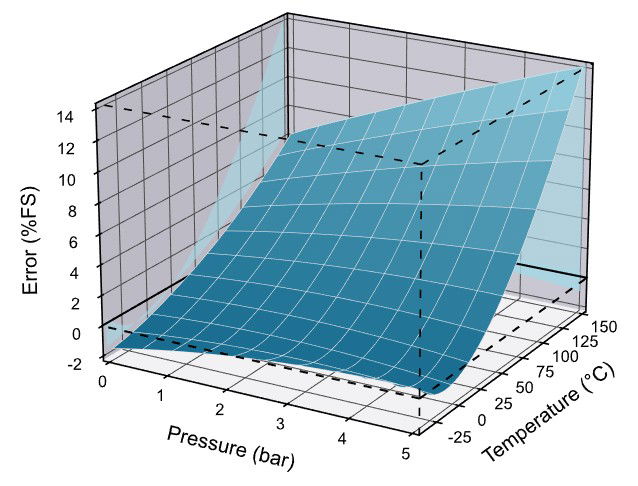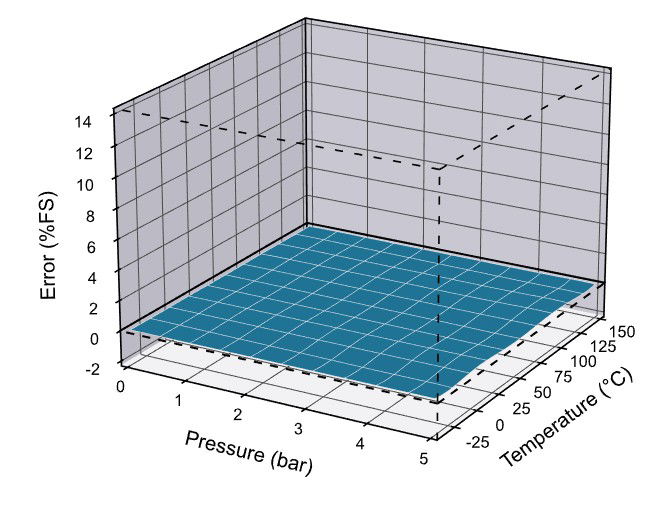Mathematical Compensation Model
05. April 2022

KELLER Pressure manufactures 1,2 million high-grade measuring cells. These measuring cells are then either installed within the most diverse array of other products or sold as OEM products. Great emphasis is always placed on ensuring the products are of high quality. Calibration is a crucial part of a pressure transmitter’s production chain. So-called compensation, i.e. the mathematical compensation model, plays a major role in this process.
Mathematical model
Wikipedia explains the concept of a «mathematical model» as follows:
«A mathematical model is a model produced using mathematical notation to describe an aspect of the observable world.» This general definition applies well to our mathematical compensation model. Simply put, the physical characteristics of the measuring cell are analysed (calibrated), modelled using so-called mathematical coefficients and any deviation from the ideal characteristic is compensated for using a polynomial formula. The result is a standardised output signal.

Calibrated

Mathematically compensated
Compensation for a pressure transmitter
By definition, the word «compensation» means balancing or cancelling out. In technology, this is understood to mean the measures taken to reduce undesirable effects or, ideally, to cancel them out entirely.
In principle, only reproducible errors can be compensated for in pressure measurement technology. Among these are non-linearity and temperature errors such as TCzero (temperature coefficient zero) and TCsens (temperature coefficient sensitivity). All other aspects such as non-reproducibility, hysteresis and long-term stability remain as they are and can only be improved physically during the production process, but not compensated for mathematically.
There is a distinction between passive compensation and active compensation.
Passive compensation means that the characteristic is measured dependent on temperature and compensated for using additional electrical resistors (passive components) in the circuitry. The temperature behaviour of resistors is practically linear. For this reason, only first-order errors can be compensated for. This method is also known as analogue compensation.
Active compensation (digital compensation) can compensate for higher-order errors. This involves continuously measuring the temperature in the pressure chip and assigning a corresponding pressure value. This makes it possible to determine coefficients for pressure and temperature. Error-free pressure values can be calculated using the following formula and additional compensation electronics.

In the past, KELLER has developed an extensive range of equipment and software for enabling highly precise and efficient calibration. Each step in the process is documented as thoroughly as possible. The measurement data is stored in a database and the polynomial calculated for compensation purposes is stored in the transmitter’s electronics. This way, the sensor’s characteristics are never lost and traceability is ensured.
Application-specific solution
Depending on the product’s expansion stage, only the sensor’s calibration data is provided, the coefficients are transmitted or (digital) electronics are responsible for compensating and processing the signals.
Options:
• Pressure transducer with calibration data
• Pressure transducer with calibration and a mathematical compensation model
• Pressure transmitter (calibration and compensation in KELLER electronics)
In the majority of cases, the best choice for customers is a pressure transmitter with compensation electronics so that they can benefit from KELLER’s years of expertise. Customers do not need to worry about signal compensation, do not need to do any programming and can integrate the product into their systems using standardised interfaces. However, compensation electronics limit the sampling rate, resolution, accuracy or a combination of performance factors and are therefore not always the ideal solution.
The majority of pressure transmitters (containing electronics) can also only be used up to an ambient temperature of approx. 125 °C. For this reason, they are not suited to higher application temperatures. Metal KELLER pressure transducers, by way of contrast, can measure pressure reliably even up to temperatures of 180 °C. Customers can achieve their desired performance even in higher-temperature applications using tailored methods of signal compensation that employ the appropriate mathematical compensation model.
A good example of this is the Series 11HT KELLER sensor with the mathematical compensation model. It was specially developed for use in electrical submersible pumps in oil wellbores with high temperatures. In spite of difficult and harsh conditions, the sensor delivers precise essential pressure information to promote efficiency of the equipment and oil drilling. The solution is a Series 7LHP pressure transducer fitted with high-temperature wires for the electrical connection, welded into housing with a customer-specific pressure connection. The customer receives calibration data from KELLER and the calculated mathematical compensation model – signal compensation is performed at a different location within the customer’s system.
KELLER has the right error compensation solution for every expansion stage of a pressure sensor.

KELLER Series 11HT – application-specific solution for electrical submersible pumps in oil wellbores



